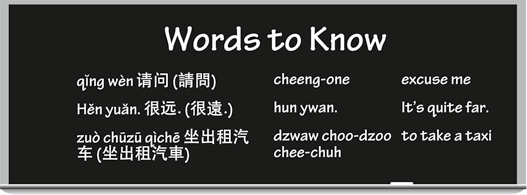Chinese For Dummies (118 page)
Read Chinese For Dummies Online
Authors: Wendy Abraham
 The word
The word
nÇr
spoken with a third (low falling and then rising) tone means
where,
but the same word said with a fourth (falling) tone,
nà r,
means
there,
so be particularly careful which tone you use when you ask for directions. The person you ask may think you're making a statement, not asking a question.
Talkin' the Talk
 Wanda is about to leave her hotel in Beijing to head for the American embassy to renew her passport. She's not sure where to find it, so she asks a hotel attendant how to get there. (Track 24)
Wanda is about to leave her hotel in Beijing to head for the American embassy to renew her passport. She's not sure where to find it, so she asks a hotel attendant how to get there. (Track 24)
Wanda:
QÇngwèn, MÄiguó dà shÇguÇn zà i nÇr?
cheeng-one, may-gwaw dah-shir-gwahn dzye nar?
Excuse me, where's the American embassy?
Attendant:
MÄiguó dà shÇguÇn zà i Xiù ShuÇ BÄi JiÄ.
may-gwaw dah-shir-gwahn dzye shyow shway bay jyeh.
The American embassy is on Xiu Shui Bei Street
.
Wanda:
HÄn yuÇn ma?
hun ywan mah?
Is it far?
Attendant:
HÄn yuÇn. NÇ zuì hÇo zuò chÅ«zÅ« qìchÄ qù.
hun ywan. nee dzway how zwaw choo-dzoo chee-chuh chyew.
Yes, it's quite far. You'd best take a taxi.
Wanda:
Xièxiè.
shyeh-shyeh.
Thanks.

Getting direction about directions
Knowing how to ask where you can find a particular place is the first step, but you also need to know how to get there. (Otherwise, why would you ask where it is in the first place, right?) Here's the simplest way to find out:
Qù _____ zÄnme zÇu?
å»
_____
æä¹èµ°
? (
å»
_____
æ麼走
?) (chyew _____ dzummuh dzoe?) (
How do I get to_____?
)
Here are some examples of how to use this question pattern:
Qù fÄijÄ«chÇng zÄnme zÇu?
å»é£æºåºæä¹èµ°
? (
å»é£æ©å ´æ麼走
?)
(chyew fay-jee-chahng dzummuh dzoe?) (
How do I get to the airport?
)
Qù túshÅ«guÇn zÄnme zÇu?
å»å¾ä¹¦é¦æä¹èµ°
? (
å»åæ¸é¤¨æ麼走
?) (chyew too-shoo-gwahn dzummuh dzoe?) (
How do I get to the library?
)
Qù xuéxià o zÄnme zÇu?
å»å¦æ ¡æä¹èµ°
? (
å»å¸æ ¡æ麼走
?) (chyew shweh-shyaow dzummuh dzoe?) (
How do I get to the school?
)
 If you get lost in any city in mainland China, you can often get back on track by asking where
If you get lost in any city in mainland China, you can often get back on track by asking where
ZhÅngshÄn Lù
ä¸å±±è·¯
(joong-shahn loo) or
JiÄfà ng Lù
解æ¾è·¯
(jyeh-fahng loo) is.
ZhÅngshÄn,
which literally means
the middle mountain,
refers to the birthplace of Dr. Sun Yat-sen, founder of the modern Chinese Republic (Taiwan) in 1911.
JiÄfà ng,
on the other hand, means
liberation
and refers to the “liberation” of the mainland by the Communists in 1949.
Lù
just means
road.
Generally, these streets are located in the middle of town. They serve as the Chinese equivalent of Main Street in Anytown, USA. Always a safe bet.
Understanding the answers to “where” questions
Short of using international sign language with a pantomime act, you may want to get a handle on some basic terms that indicate direction and location. Read on for a quick list:
 duìmià n
duìmià n
对é¢
(
å°é¢
) (dway-myan) (
opposite
)
 fùjìn
fùjìn
éè¿
(foo-jeen) (
near
)
 hòu
hòu
å
(
å¾
) (ho) (
back
)
 kà ojìn
kà ojìn
é è¿
(kaow-jeen) (
next to
)
 lÇ
lÇ
é
(
ç
) (lee) (
inside
)
 qián
qián
å
(chyan) (
front
)